Physical Address
304 North Cardinal St.
Dorchester Center, MA 02124
Chorioamnionitis (or intra-amniotic infection) is a major cause of fetal, neonatal, and maternal morbidity and mortality. There are strong associations between chorioamnionitis and maternal morbidity, preterm birth, early-onset neonatal sepsis, bronchopulmonary dysplasia, retinopathy of prematurity, and diffuse white matter injury. The literature supporting these associations has been inconsistent, largely because of lack of precision in the diagnosis of chorioamnionitis. Potential sites of microbial invasion include the choriodecidual space (between maternal tissues and the fetal membranes), the fetal membranes, the placenta, the amniotic fluid, the umbilical cord, and the fetus ( Fig. 25.1 ). When characteristic clinical signs are present, the condition is usually termed clinical chorioamnionitis. However, histologic chorioamnionitis (inflammation of the chorion and amnion) is three times as common as clinical chorioamnionitis confirmed by amniotic fluid culture. Two main varieties of chorioamnionitis can be identified, acute chorioamnionitis and subclinical chorioamnionitis. They differ in their clinical manifestations, microbiology, and risk to the fetus ( Fig. 25.2 ). Although acute chorioamnionitis is strongly associated with early-onset sepsis, the subclinical variety may contribute to the risk of chronic lung disease and brain injury.
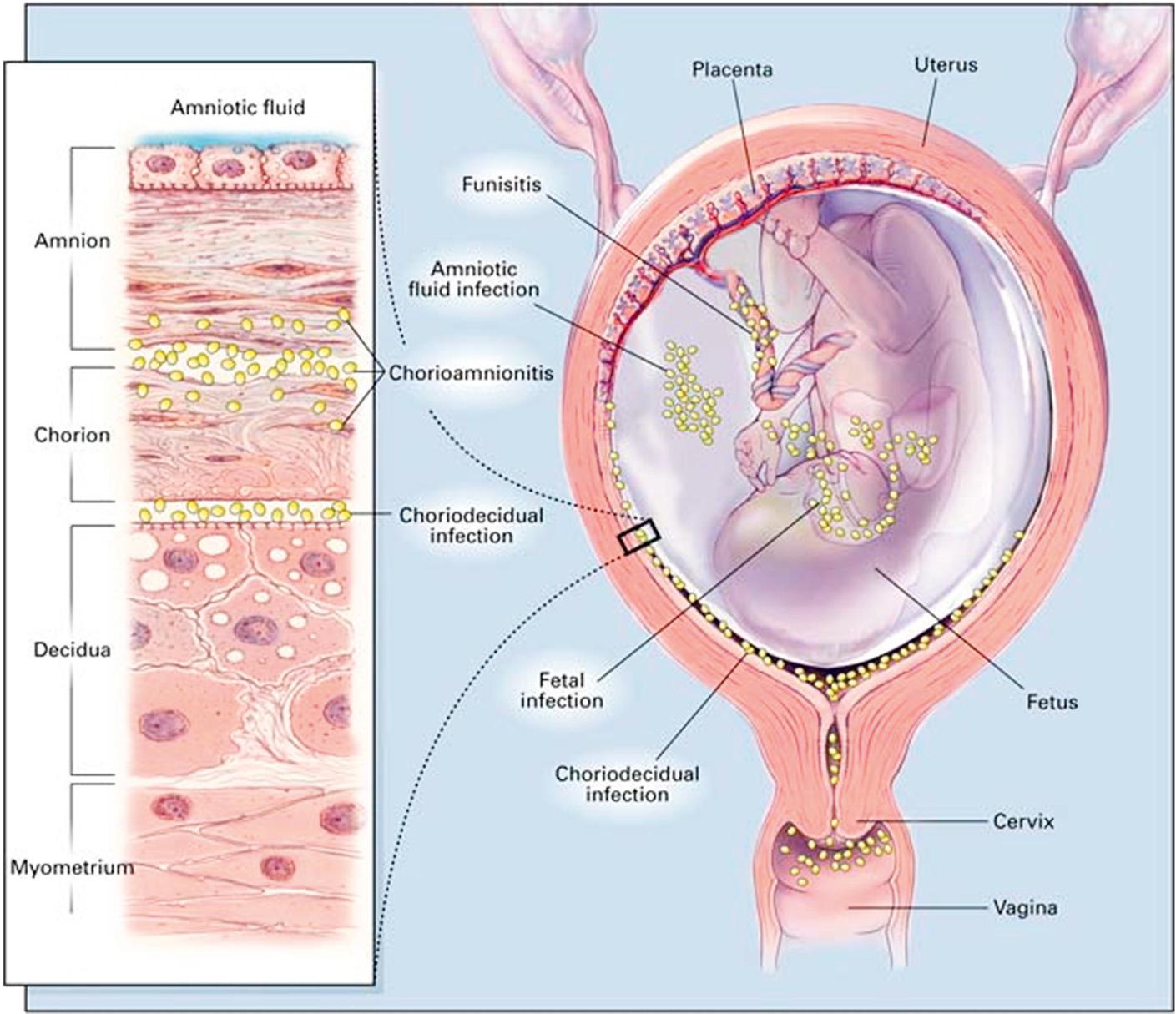
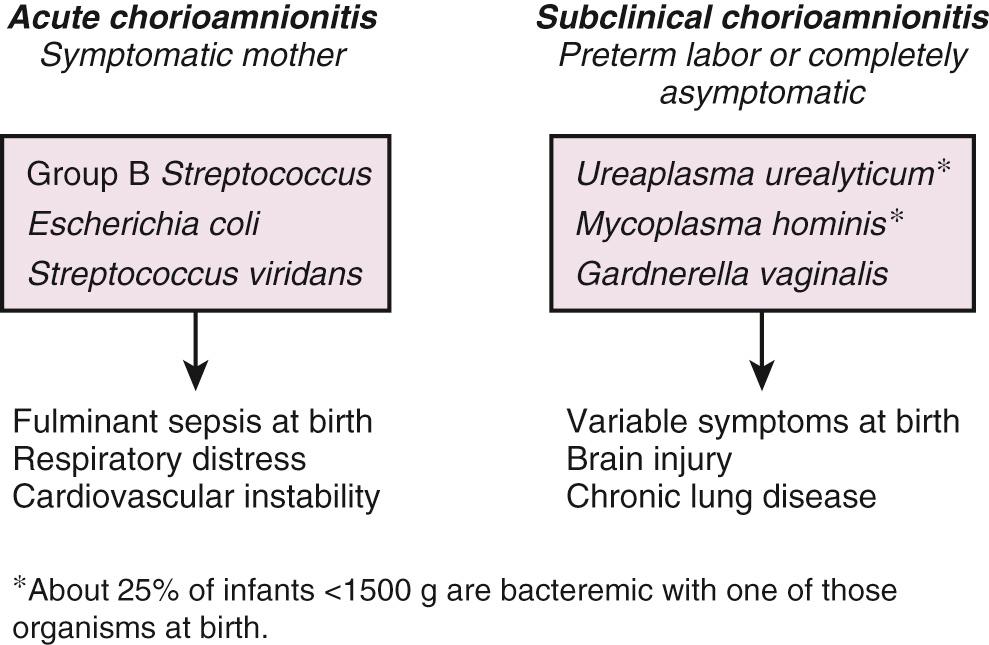
Chorioamnionitis complicates 1%-4% of all pregnancies; though, the reported incidence varies widely based upon gestational age and diagnostic criteria used. The prevalence of histologic chorioamnionitis ranges from 50%-70% in very low–birth weight infants to 10%-15% for infants born at term gestation. Approximately 30% of women with preterm labor and intact membranes exhibit histologic chorioamnionitis, as do 80% of women with preterm, premature rupture of membranes (PPROM). Histologic chorioamnionitis almost always represents an ascending infection of organisms colonizing the maternal birth canal. Histologic acute chorioamnionitis represents the inflammatory response of the mother and fetus to the presence of microorganisms (usually bacterial or fungal) in the amniotic cavity. Acute chorioamnionitis cannot occur before the fusion of the amnion and chorion (≈11 weeks’ gestation) and is rare before 20 weeks of gestation. Before that time, a chronic choriodeciduitis can develop, which is subclinical and has been linked to an increased incidence of preterm birth, chronic lung disease, and periventricular leukomalacia. It is controversial whether the choriodeciduitis represents an infectious process or a maternal immune response to fetal antigens.
As noted, histologic chorioamnionitis is three times as common as clinical chorioamnionitis, and only about two-thirds of women with suspected clinical chorioamnionitis have evidence of placental inflammation. Part of the difficulty of identifying women with chorioamnionitis is that microbial invasion of the amniotic cavity (MIAC) can be chronic and clinically silent. Furthermore, histologic chorioamnionitis can occur with negative cultures from amniotic fluid. Some of these “negative cultures” can be explained by the fastidiousness of the microorganisms found in amniotic fluid and the difficulty in recovering them using standard culture techniques. Others result from sterile inflammation, in which an immune process caused by maternal antifetal rejection leads to the infiltration of maternal lymphocytes, plasma cells, and/or macrophages. Histologic chorioamnionitis has been associated with intra-amniotic infection in 72% of cases of preterm birth. However, the likelihood of neonatal sepsis in women with histologic or clinical chorioamnionitis varies dramatically with gestational age ( Table 25.1 ).
| 22 Weeks | 23 Weeks | 24 Weeks | 25 Weeks | 26 Weeks | 27 Weeks | 28 Weeks | |
|---|---|---|---|---|---|---|---|
| Histologic chorioamnionitis | 70% | 61% | 59% | 51% | 48% | 41% | 34% |
| Clinical chorioamnionitis | 28% | 26% | 20% | 19% | 19% | 15% | 14% |
| Early-onset sepsis | 6% | 4% | 4% | 2% | 2% | 2% | 1% |
Epidemiologic investigations have demonstrated several factors associated with the development of clinical chorioamnionitis, including maternal colonization with group B streptococcus (GBS), GBS bacteriuria, nulliparity, the use of internal monitoring devices, meconium-stained amniotic fluid, serial vaginal digital examinations, duration of active labor, and duration of membrane rupture. Importantly, meconium-stained amniotic fluid is not only a risk factor for chorioamnionitis but also may be a consequence of fetal stress secondary to intra-amniotic infection. There are some data to suggest that women diagnosed with chorioamnionitis during their first pregnancy are at increased risk for developing chorioamnionitis in subsequent pregnancies, indicating a persistent predisposing condition or particular underlying host susceptibility. Recent gene association studies have identified single nucleotide polymorphisms in immunoregulatory genes that may influence susceptibility to chorioamnionitis. The presence of abnormal cervicovaginal flora (e.g., bacterial vaginosis, aerobic vaginitis) during the first trimester is associated with adverse pregnancy outcomes, including early preterm birth and miscarriage and MIAC, although discrete evidence linking the presence of abnormal flora of the lower genital tract with the development of acute clinical chorioamnionitis is lacking. Rather, it is hypothesized that these vaginal microbes ascend into the intrauterine cavity and induce a subclinical, chronic inflammatory response that in turn predisposes to preterm rupture of membranes and/or the onset of preterm labor.
Chorioamnionitis is almost always polymicrobial. Using culture-based techniques, Ureaplasma urealyticum and Mycoplasma hominis are the most common organisms recovered (47% and 30%, respectively) in culture-proved chorioamnionitis. Other cultivable organisms include anaerobes, such as Gardnerella vaginalis (25%) and Bacteroides (30%), and aerobes, including GBS (15%) and Escherichia coli (8%).
Broad-range PCR has been used to identify the kinds of microorganisms found in the amniotic fluid of women with preterm labor or PPROM. Several conclusions are evident: (1) PCR-based techniques identify 30%-50% more organisms than culture-based methods; (2) five phyla are commonly represented ( Fig. 25.3 ); and (3) the patterns of microorganisms in amniotic fluid in women with preterm labor and intact membranes are different from those found in amniotic fluid samples from women with PPROM ( Figs. 25.4 and 25.5 ). However, given the high sensitivity of PCR, the increased likelihood of detecting DNA from nonviable or environmental contaminants makes the clinical significance of this microbial diversity somewhat uncertain. Studies of the association of MIAC (using PCR-based techniques) with fetal inflammation or perinatal outcomes noted statistically significant associations with elevated concentrations of inflammatory mediators in amniotic fluid and increased rates of histologic chorioamnionitis and preterm delivery.
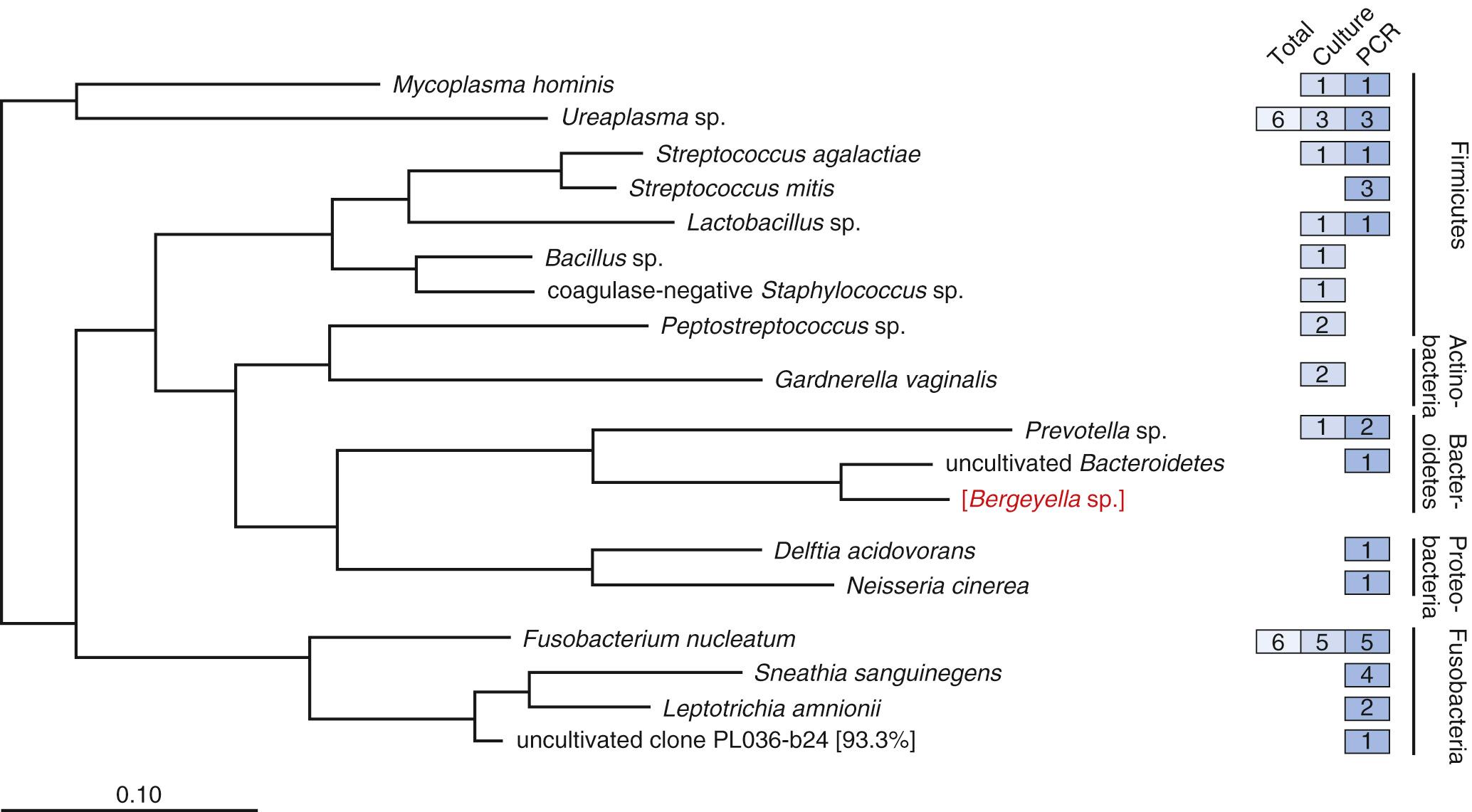
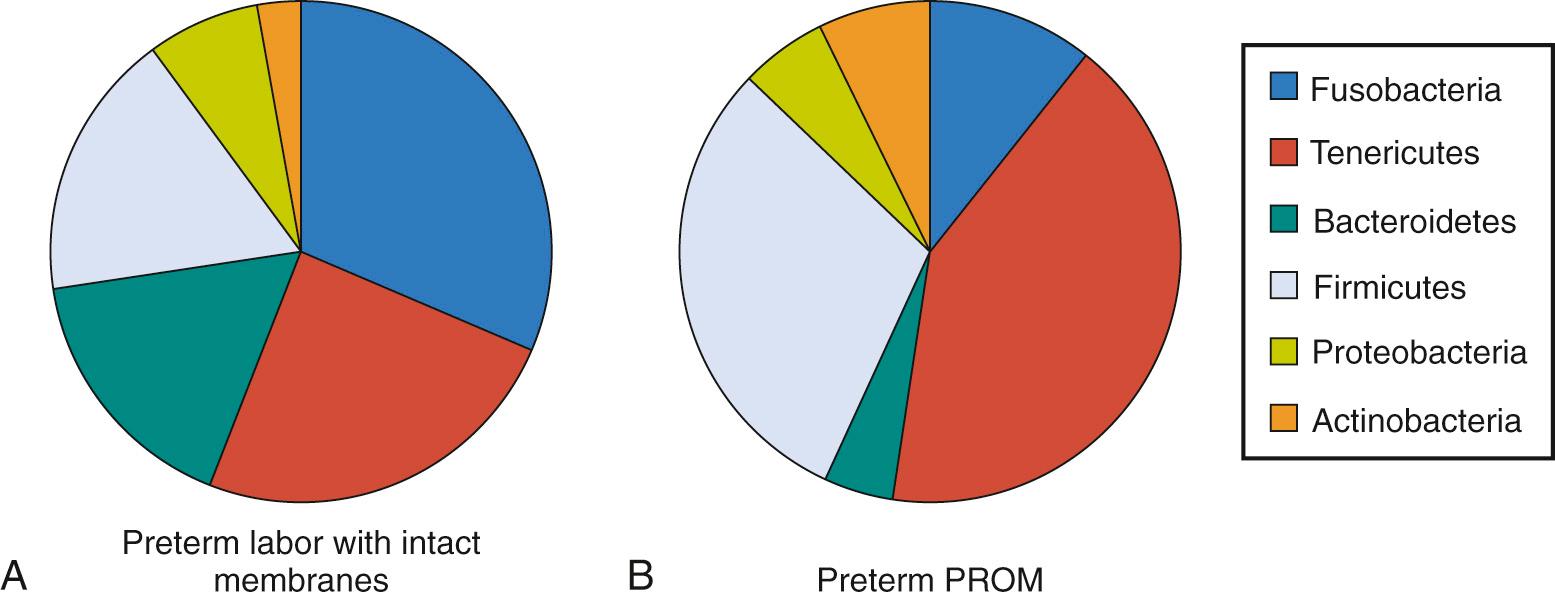
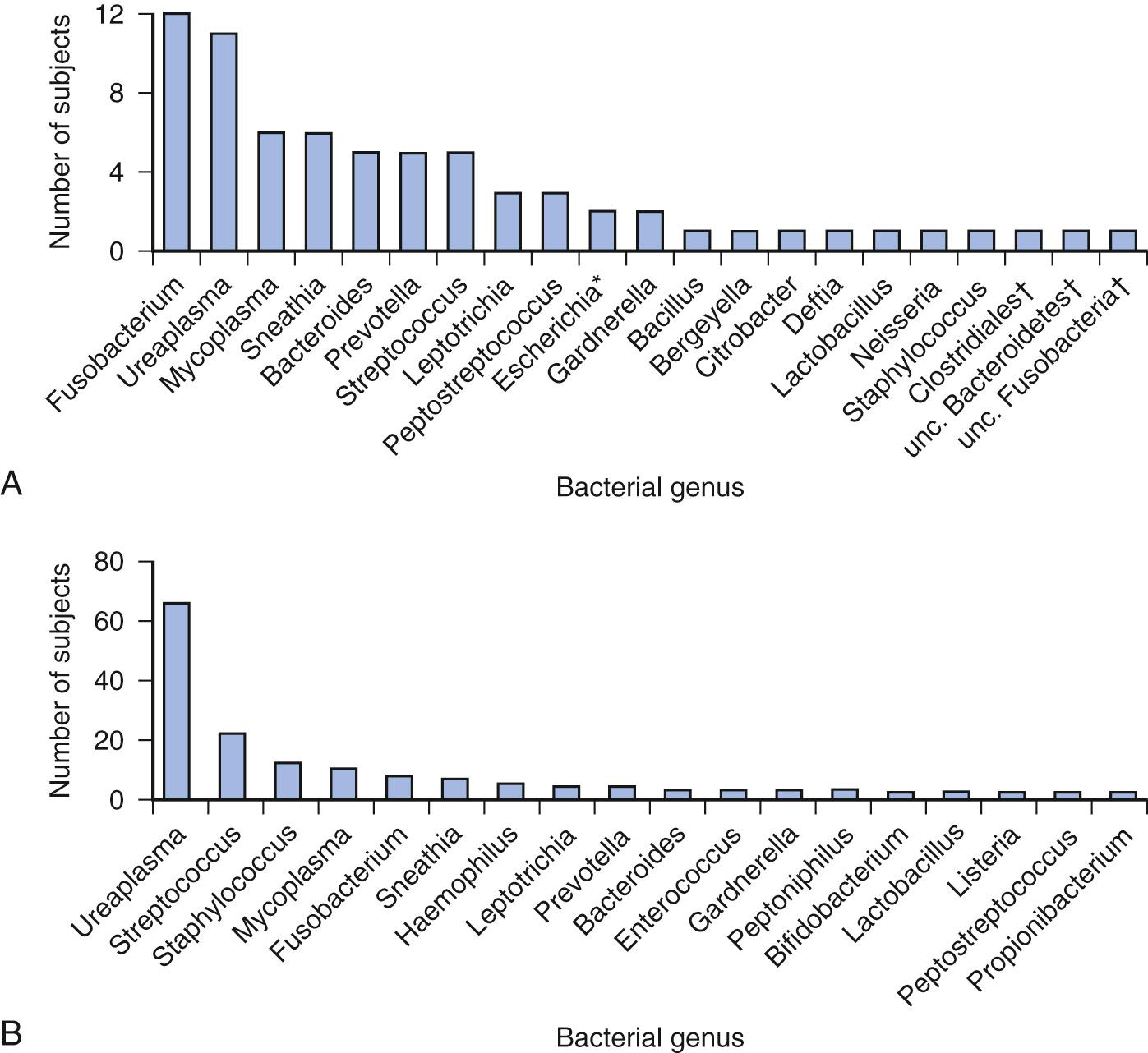
Become a Clinical Tree membership for Full access and enjoy Unlimited articles
If you are a member. Log in here